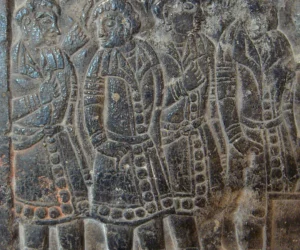The Intricate Journey of the Anyang Funerary Bed: Unveiling a Blend of Cultures The Anyang Funerary Bed, also known as the Bed of Ts’ao Ts’ao, is a captivating glimpse into the cultural exchange between China and Sogdiana during the 6th century AD. Dating back to the Northern Qi dynasty (550-577 AD), this elaborate bed belonged…
Northern Qi dynasty
The Northern Qi dynasty, reigning from AD 550 to 577, was a significant period in Chinese history, marking the division of China into northern and southern realms. This era, nestled within the broader context of the Northern and Southern Dynasties period, was characterized by its vibrant culture, military endeavors, and the flux of Buddhism as a dominant religious force. The dynasty was founded by Emperor Wenxuan, originally named Gao Yang, who was of Xianbei descent, showcasing the diverse ethnic landscape of China during this epoch.
The Northern Qi was established following the disintegration of the Northern Wei dynasty and succeeded by the Eastern Wei. Emperor Wenxuan’s ascension to the throne marked the beginning of a dynasty that would see rapid territorial expansion and significant cultural development. The dynasty’s capital was set in Ye, present-day Linzhang County, Hebei, which became a bustling center of political and cultural activity. The Northern Qi, despite its relatively short lifespan, played a crucial role in the consolidation of Buddhism in China, facilitating its spread and integration into Chinese society.
Buddhism’s influence during the Northern Qi dynasty was profound, with state sponsorship of Buddhist monasteries and the construction of grand statues and temples. This period saw an increase in the translation of Buddhist texts into Chinese, contributing to the religion’s accessibility and popularity. The dynasty’s rulers, particularly Emperor Wenxuan and his successors, were known for their patronage of Buddhism, which not only enhanced their political legitimacy but also fostered a cultural renaissance.
Social and daily life in the Northern Qi dynasty was marked by a blend of Chinese and non-Chinese traditions, reflecting the diverse ethnic composition of its population. The aristocracy and the common people engaged in various cultural practices, from poetry and painting to music and dance, that were influenced by both Chinese and foreign elements. The civil service examination system, which became a hallmark of Chinese bureaucratic governance, was further developed during this period, emphasizing Confucian learning while also accommodating the growing influence of Buddhism.
The Northern Qi dynasty was a time of military ambition and conflict, frequently engaging in warfare with its southern counterpart, the Chen dynasty, and other nomadic tribes. The dynasty’s military was characterized by its cavalry, which was highly regarded for its mobility and effectiveness. Despite its military prowess, the Northern Qi faced internal strife and rebellion, which, coupled with external pressures, eventually led to its downfall.
The dynasty’s rulers were a mix of capable administrators and military strategists, with Emperor Wenxuan and his son, Emperor Xiaozhao, being notable for their contributions to the dynasty’s initial stability and expansion. However, subsequent rulers struggled to maintain control, leading to a decline in central authority and the eventual conquest by the Northern Zhou dynasty in AD 577.
The fall of the Northern Qi dynasty marked the end of a vibrant but tumultuous period in Chinese history. Its contributions to Chinese culture, particularly in the realms of religion, art, and governance, however, left a lasting legacy that would influence subsequent dynasties. The integration of diverse cultural elements and the promotion of Buddhism during this period were particularly significant, shaping the religious and cultural landscape of China for centuries to come.
In conclusion, the Northern Qi dynasty, though short-lived, was a period of significant cultural and military activity in Chinese history. Its rulers navigated the complexities of governing a diverse and often fractious territory, contributing to the rich tapestry of China’s imperial legacy. The dynasty’s promotion of Buddhism and its efforts to integrate various cultural influences underscored the dynamic nature of Chinese civilization during this era.

Xiangtangshan Caves
Historical Significance of Xiangtangshan Caves Artisans first carved the Xiangtangshan Caves during the Northern Qi Dynasty, between AD 550 and 577. Subsequently, artists from the Sui, Tang, Song, and Ming dynasties also contributed to the caves’ development. These caves, located in Hebei province, stand out as the largest in the region. Craftsmen chose the top-quality…

